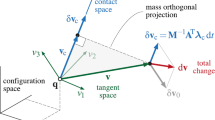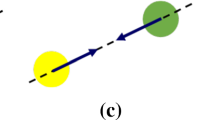Abstract
This paper addresses an issue related to a multi-rigid-body frictional contact application, the non-jamming condition for the applying force such that the workpiece can move while maintaining existing contacts. The issue arises from the study of fixture loading planning. While rigid-body frictional contacts could restrict workpiece motion in both normal and tangential directions, it is found that the reason for jamming is from the tangential constraints by frictional forces. We first enumerate all the possible contact states for multiple contacts, and the contact constraints are classified into two categories, the configuration constraints and kinematic constraints. We then find an interesting result related with a non-jamming condition. That is, in a general situation, the applying force that can induce all-sliding contacts will never result in jamming. Moreover, a method to find the applied force on the workpiece that results in sliding on all contact points is presented, based on the sufficient condition for non-jamming. Numerical examples are presented and the results of the method are compared with the results of a quasi-static method.
Similar content being viewed by others
References
Painlevé, P.: Sur les lois du frottement de glissement. C. R. l’Acad. Sci. 121, 112–115 (1895)
Mason, M.T., Wang, Y.: On the inconsistency of rigid-body frictional planar mechanics. In: Proceedings of IEEE International Conference on Robotics and Automation, pp. 524–528. Philadelphia, PA, April (1988)
Dupont, P.E., Yamajako, S.P.: Jamming and wedging in constrained rigid-body dynamics. In: Proceedings of 1994 IEEE International Conference on Robotics and Automation, pp. 2349–2354 (1994)
Stewart, D.E.: Rigid-body dynamics with friction and impact. SIAM Rev. 42(1), 3–39 (2000)
Trinkle, J., Zeng, D.: Prediction of the quasistatic planar motion of a contacted rigidbody. IEEE Trans. Robot. Autom. 11(2), 229–246 (1995)
Trinkle, J.C., Yeap, S.L., Han, L.: When quasistatic jamming is impossible. In: Proceedings of 1996 IEEE International Conference on Robotics and Automation (1996)
Asada, H., By, A.B.: Kinematics analysis of workpart fixturing for flexible assembly with automatically reconfigurable fixtures. IEEE J. Robot. Autom. RA-1(2), 86–93 (1985)
Chou, Y.-C., Chandru, V., Barash, M.M.: A mathematical approach to automated configuration of machining fixtures: Analysis and synthesis. J. Eng. Ind. 111, 299–306 (1989)
Markenscoff, X., Ni, L., Papadimitriou, C.H.: The geometry of grasping. Int. J. Robot. Res. 9(1), 61–74 (1990)
Cai, W., Hu, S.J., Yuan, J.: A variational method of robust fixture configuration design for 3-d workpieces. J. Manuf. Sci. Eng. 119, 593–602 (1997)
Wang, M.Y.: An optimal design for 3-d fixture synthesis in a point set domain. IEEE Trans. Robot. Autom. 16(6), 839–846 (2000)
Wang, M.Y., Liu, T., Pelinescu, D.M.: Fixture kinematic analysis based on the full contact model of rigid bodies. ASME Trans. J. Manuf. Sci. Eng. 125(2), 316–324 (2003)
Weck, M., Bibring, H.: Handbook of Machine Tools, vol. 1. Wiley, New York (1984)
Wang, M.Y., Pelinescu, D.M.: Contact force prediction and force closure analysis of a fixtured rigid workpiece with friction. J. Manuf. Sci. Eng. 125(2), 325–332 (2003)
Schimmels, J.M., Peshkin, M.A.: Force-assembly with friction. IEEE Trans. Robot. Autom. 10(4), 465–479 (1994)
Baraff, D.: Fast contact force computation for nonpenetrating rigid bodies. In: Computer Graphics Proceedings, Annual Conference Series, pp. 23–34. Orlando (1994)
Förg, M., Pfeiffer, F., Ulbrich, H.: Simulation of unilateral constrained systems with many bodies. Multibody Syst. Dyn. 14(2), 137–154 (2005)
Glocker, C., Studer, C.: Formulation and preparation for numerical evaluation of linear complementarity systems in dynamics. Multibody Syst. Dyn. 13(4), 447–463 (2005)
Pfeiffer, F., Förg, M., Ulbrich, H.: Numerical aspects of non-smooth multibody dynamics. Comput. Methods Appl. Mech. Eng. 195(50–51), 6891–6908 (2006)
Pang, J., Trinkle, J.: Complementarity formulations and existence of solutions of dynamic multi-rigid-body contact problems with coulomb friction. Math. Program. 73, 139–154 (1996)
Tzitzouris, J. Jr.: Numerical resolution of frictional multi-rigid-body systems via fully implicit time-stepping and nonlinear complementarity. Ph.D. Dissertation, The Johns Hopkins University, Baltimore, Maryland, 2001
Ding, D., Liu, Y.-H., Wang, S.: Computation of 3-d force-closure grasps. IEEE Trans. Robot. Autom. 17(4), 515–522 (2001)
Abadie, M.: Dynamic simulation of rigid bodies: Modelling of frictional contact. In: Brogliato, B. (ed.) Impacts in Mechanical Systems: Analysis and Modelling, pp. 61–144. Springer, Berlin (2000)
Liu, T., Wang, M.Y.: Computation of three-dimensional rigid-body dynamics with multiple unilateral contacts using time-stepping and Gauss-Seidel methods. IEEE Trans. Autom. Sci. Eng. 2(1), 19–31 (2005)
Whitney, D.E.: Quasi-static assembly of compliantly supported rigid parts. J. Dyn. Syst. Meas. Control 104, 65–77 (1982)
Trinkle, J.C., Balkcom, D., Gottlieb, E.J.: Computing wrench cones for planar contact tasks. In: Proceedings of 2002 IEEE International Conference on Robotics and Automation, pp. 869–875. Washington, DC (2002)
Schimmels, J.M., Peshkin, M.A.: Admittance matrix design for force-guided assembly. IEEE Trans. Robot. Autom. 8(2), 213–227 (1992)
Lozano-Perez, T., Mason, M.T., Taylor, R.H.: Automatic synthesis of fine-motion strategies for robots. Int. J. Robot. Res. 3(1), 3–24 (1984)
Xia, Y., Yin, Y., Chen, Z.: Dynamic analysis for peg-in-hole assembly with contact deformation. Int. J. Adv. Manuf. Technol. 30, 118–128 (2006)
Zhou, J., Georganas, N.D., Petriu, E.M., Shen, X., Marlic, F.: Modelling contact forces for 3d interactive peg-in-hole virtual reality operations. In: IEEE Instrumentation and Measurement (I2MTC 2008), British Columbia, Canada, May (2008)
Leine, R.I., Glocker, C., van Campen, D.H.: Nonlinear dynamics of the woodpecker toy. In: Proceedings of ASME 2001 Design Engineering Technical Conference and Computers and Information in Engineering Conference, no. DETC2001/VIB-21608. Pittsburgh, PA: ASME, September (2001)
Leine, R., van Campen, D.: Bifurcation phenomena in non-smooth dynamical systems. Eur. J. Mech. A/Solids 25, 595–616 (2006)
Yoshikawa, T.: Passive and active closures by constraining mechanisms. J. Dyn. Syst. Meas. Control 121, 418–424 (1999)
Shapiro, A., Rimon, E., Burdick, J.W.: Passive force closure and its computation in compliant-rigid grasps. In: Proceedings of IEEE/RSJ International Conference on Intelligent Robots and Systems (IROS), vol. 2, pp. 1769–1775. Maui, Hawaii, October (2001)
Wang, M.Y., Liu, Y.H.: Force passivity in fixturing and grasping. In: Proceedings of IEEE International Conference on Robotics and Automation, pp. 2236–2241. Taipei, Taiwan, September (2003)
Murray, R.M., Li, Z., Sastry, S.S.: A Mathematical Introduction to Robotic Manipulation. CRC Press, Boca Raton (1994)
Montana, D.J.: The kinematics of contact and grasp. Int. J. Robot. Res. 7(3), 17–32 (1988)
Balkcom, D., Trinkle, J.C.: Computing wrench cones for planar rigid body contact tasks. Int. J. Robot. Res. 21(12), 1053–1066 (2002)
Sarkar, N., Kumar, V., Yun, X.: Velocity and acceleration analysis of contact between three-dimensional rigid bodies. ASME J. Appl. Mech. 63, 974–984 (1996)
Trinkle, J.C., Tzitzouris, J.A., Pang, J.S.: Dynamic multi-rigid-body systems with concurrent distributed contacts. Philos. Trans. Math. Phys. Eng. Sci. Ser. A 359(1789), 2575–2593 (2001)
Montana, D.J.: The kinematics of multi-fingered manipulation. IEEE Trans. Robot. Autom. 11(4), 491–503 (1995)
Nelson, D.D., Johnson, D.E., Cohen, E.: Haptic rendering of surface-to-surface sculpted model interaction. In: 8th Annual Symp. on Haptic Interfaces for Virtual Environment and Teleoperator Systems. November (1999)
Author information
Authors and Affiliations
Corresponding author
Additional information
This research work was supported in part by the Research Grants Council of Hong Kong SAR (Project No. CUHK416206) and the Ministry of Science and Technology of China through the 973 Fund (No. 2007CB707703).
Rights and permissions
About this article
Cite this article
Liu, T., Wang, M.Y. & Low, K.H. Non-jamming conditions in multi-contact rigid-body dynamics. Multibody Syst Dyn 22, 269–295 (2009). https://doi.org/10.1007/s11044-009-9165-3
Received:
Accepted:
Published:
Issue Date:
DOI: https://doi.org/10.1007/s11044-009-9165-3




